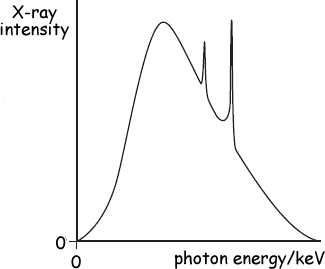'A' Level Medical Option Questions - X-Rays
Q10.
(a) The X-ray spectrum for a certain X-ray tube target is shown below. Explain the process which gives rise to spikes at certain photon energies.
Electrons strike the metal anode and ionise/excite the target atoms. This causes vacancies in inner electron levels. 
Excited/higher electrons fall to inner/lower energy level states and the change in energy is released as a electromagnetic photon.  Most of these photons are in the infra-red energy range but some are of X-Ray energy.
Most of these photons are in the infra-red energy range but some are of X-Ray energy.
The gaps between the energy levels in a particular atom are fixed. Therefore the transitions that produce X-rays will be fixed for a particular target element.  This is why the X-rays produced will be of a certain energy - these X-rays form the characteristic peaks.
This is why the X-rays produced will be of a certain energy - these X-rays form the characteristic peaks.
(3 marks)

(b) A film cassette, placed under a patient being X-rayed, is shown below:

Explain how the intensifying screens in the film cassette achieve their purpose and state
their benefit to the patient.
Most X-rays pass through the cassette and do not interact with it at all. Including the two intensifying screen layers as well as the film increases the chance of X-ray interaction being detected. Therefore the use of such screens reduces the radiation dose to the patient by making the exposure time shorter.
X-rays that interact with the film cause exposure. The intensifying screens have a fluorescent coating; this converts any X-ray photons that interact with it into light photons.  The light photons produced, that are emitted in the direction of the film, expose the film in the correct place due to closeness of the screens to the film.
The light photons produced, that are emitted in the direction of the film, expose the film in the correct place due to closeness of the screens to the film.  You therefore do not need such a big dose of X-rays to achieve the required exposure.
You therefore do not need such a big dose of X-rays to achieve the required exposure.
(3 marks)
(Total 6 marks)


